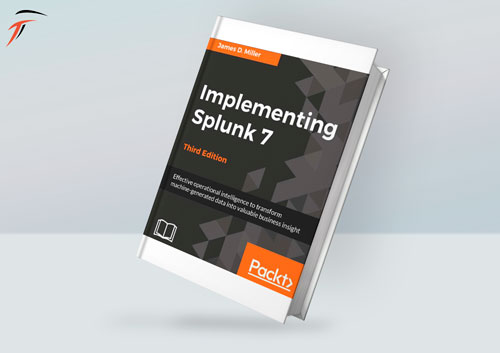معرفی کتاب Implementing Splunk 7, 3rd Edition

با سلام خدمت همراهان همیشگی فرکیان تک. با شما هستیم با کتاب Implementing Splunk 7 . این کتاب بر مفاهیم نرم افزار Splunk تمرکز کرده است.
معرفی کتاب :
Splunk پلتفرم پيشرو است که روش شناسي کارآمدي را تقويت مي کند و راه حل هایی را براي جستجو، نظارت و تجزيه و تحليل حجم رو به رشد داده هاي بزرگ ارائه مي دهد. اين کتاب به شما امکان مي دهد خدمات جديدي را پياده سازي کنيد و از آنها براي پردازش سريع و کارآمد داده هاي بزرگ توليد شده توسط ماشين استفاده کنيد . علاوه براین با داشبوردهاي XML، کار با برنامه ها، ساخت داشبوردهاي پيشرفته، پيکربندي و گسترش Splunk، استقرارهاي پيشرفته و موارد ديگر آشنا خواهيد شد . در پايان اين کتاب، با نرم افزار Splunk آشنا خواهيد شد و خدمات Splunk را در پروژه ها پياده سازي خواهيد کرد.
فهرست مطالب :
1: رابط Splunk
2: درک جستجو
3: جداول، نمودارها و فيلدها
4: مدل هاي داده و محورها
5: داشبوردهاي XML ساده
6: نمونه هاي جستجوي پيشرفته
7: ساخت داشبوردهاي پيشرفته
8: فهرست هاي خلاصه و فايل هاي CSV
9: پيکربندي Splunk
10: استقرارهاي پيشرفته
11: گسترش Splunk
12: مجموعه ابزار يادگيري ماشين
آنچه خواهيد آموخت :
تسلط بر ويژگي هاي جديد آخرين نسخه Splunk Enterprise 7
بر پيشنهادات جديد Splunk: Splunk Cloud و Machine Learning Toolkit مسلط شويد
ایجاد جستجوهاي کارآمد و موثر در سازمان
تمرکز جداول ، نمودارها و بهبود نمودارهاي Splunk
استفاده از مدلها و محورهاي داده Splunk با شتاب مدل دادهاي سريعتر استفاده کنيد
با برنامه هاي کاربردي به تمام جنبه هاي داشبورد Splunk XML مسلط شويد
ایجاد داشبوردهاي پيشرفته Splunk
براي مشاهده تمامي کتاب هاي زبان اصلي بر روي لينک کليک کنيد .
با ما همراه باشید.
Book Description
Splunk is the leading platform that fosters an efficient methodology and delivers ways to search, monitor, and analyze growing amounts of big data. This book will allow you to implement new services and utilize them to quickly and efficiently process machine-generated big data.
We introduce you to all the new features, improvements, and offerings of Splunk . We cover the new modules of Splunk: Splunk Cloud and the Machine Learning Toolkit to ease data usage. Furthermore, you will learn to use search terms effectively with Boolean and grouping operators. You will learn not only how to modify your search to make your searches fast but also how to use wildcards efficiently.
Later you will learn how to use stats to aggregate values, a chart to turn data, and a time chart to show values over time; you’ll also work with fields and chart enhancements and learn how to create a data model with faster data model acceleration. Once this is done, you will learn about XML Dashboards, working with apps, building advanced dashboards, configuring and extending Splunk, advanced deployments, and more. Finally, we teach you how to use the Machine Learning Toolkit and best practices and tips to help you implement Splunk services effectively and efficiently.
By the end of this book, you will have learned about the Splunk software as a whole and implemented Splunk services in your tasks at projects
Table of Contents
1: The Splunk Interface
2: Understanding Search
3: Tables, Charts, and Fields
4: Data Models and Pivots
5: Simple XML Dashboards
6: Advanced Search Examples
7: Extending Search
8: Working with Apps
9: Building Advanced Dashboards
10: Summary Indexes and CSV Files
11: Configuring Splunk
12: Advanced Deployments
13: Extending Splunk
14: Machine Learning Toolkit
What You Will Learn
Focus on the new features of the latest version of Splunk Enterprise 7
Master the new offerings in Splunk: Splunk Cloud and the Machine Learning Toolkit
Create efficient and effective searches within the organization
Master the use of Splunk tables, charts, and graph enhancements
Use Splunk data models and pivots with faster data model acceleration
Master all aspects of Splunk XML dashboards with hands-on applications
Create and deploy advanced Splunk dashboards to share valuable business insights with peers
